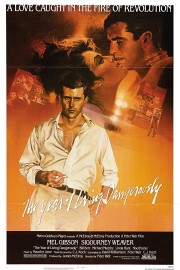The Year of Living Dangerously
This is my first time watching “The Year of Living Dangerously,” Peter Weir’s 1983 thriller with Mel Gibson as an Australian journalist in 1965 Indonesia during a time of deep political unrest. I chose it precisely for that reason to review leading up to Gibson’s return to acting in “Edge of Darkness.” Seeing it fresh, I think I made a pretty good choice.
Peter Weir is a director you can expect to see more of on Sonic Cinema in the coming year, starting with my fresh review of his “The Truman Show” last year (his 1981 collaboration with Gibson, “Galipolli,” will be reviewed in the next year as well). This adaptation of the novel by C.J. Koch is the type of film we see too rarely anymore- politically brave, intelligent, riveting, which is just the type of film we’ve come to expect from Weir (“Witness,” “Master and Commander: The Far Side of the World,” “The Mosquito Coast”) over the years. It’s a shame he doesn’t work more.
Gibson’s Guy Hamilton is young and ambitious when he sets foot in Indonesia for the first time, without anyone who can show him the ropes of how to work in such a climate (his predecessor has already left the country). That’s where the diminutive Billy Kwan comes in. A cameraman who’s well connected with political contacts, he’s our introduction to this world, and Guy’s as well. The two form a bond that’s beneficial for both.
Billy Kwan is played by Linda Hunt in one of the great Oscar-winning performances of the past 30 years, if not of all-time (she deservingly won Best Supporting Actress for the role). You don’t think about the fact that you’re watching a woman play a man- that’s how fully she embodies the role. Hamilton’s story is the film’s center, but Kwan’s is the one we identify with most, especially when Hamilton begins an affair with a British attache (Sigourney Weaver) that is more about the larger political atmosphere than any romantic notions of journalism, especially when Weaver’s Jill tells him about an arms shipment that will change the entire region.
Weir and Gibson were part of the “Australian New Wave” in the late ’70s and early ’80s. That era of filmmakers also included George Miller (the “Mad Max” films), Philip Noyce (“Patriot Games”), and actors like Nicole Kidman, Judy Davis (“The Ref”), and Sam Neill. But Weir and Gibson are the crown-jewels of this movement. More than any of the rest, these two not only found popular and critical success, but also never really strayed from these early risks. If this film (the first major studio collaboration on an Australian production), which no major studio would likely produce today (without a healthy amount of coercion, at least) shows anything, it’s that it’s time these two found a chance to collaborate again.










